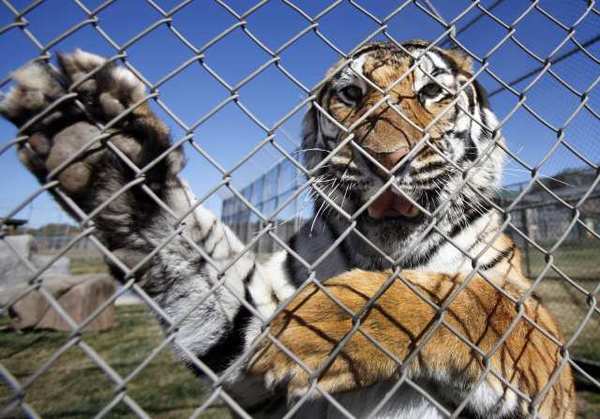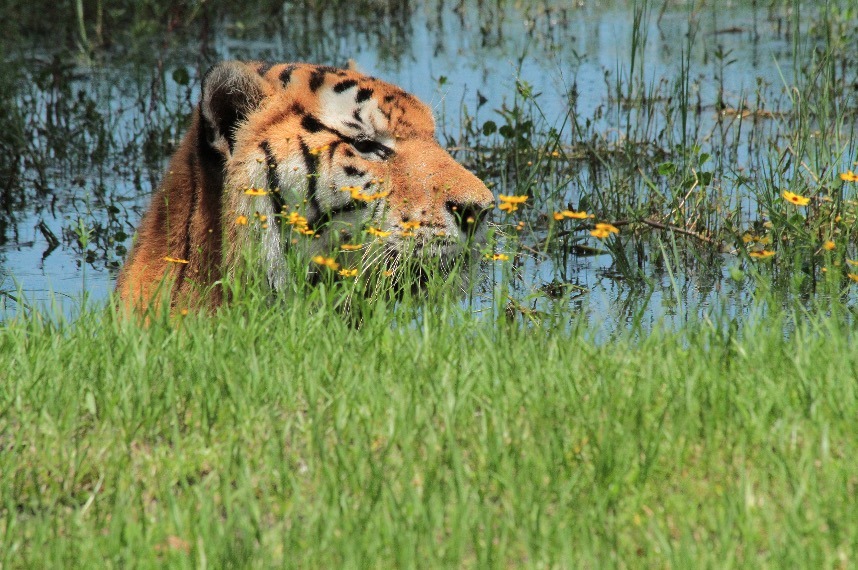IS IT LEGAL TO TRANSFER TIGERS ACROSS STATE LINES?
We frequently get asked is it “legal” under federal law to transfer a tiger to a facility in another state. The answer is not a simple yes or no, and in addition to what the law says there are some serious practical issues when it comes to enforcement. There are two federal laws that apply: the Endangered Species Act (ESA) and the Lacey Act, which was amended by the Captive Wildlife Safety Act (CWSA). We are not lawyers but here is our layman’s understanding of how these laws related to the sale of captive tigers in the United States. The laws are discussed in more detail below. But, in brief:
– USDA licensed exhibitors can transfer tigers to another USDA licensee under the CWSA. However, this does not mean the transfer is legal under the ESA.
– The US Fish & Wildlife Service (FWS) interprets the ESA as only prohibiting the sale of tigers across state lines without applying to FWS for a Captive Bred Wildlife (CBW) permit. This creates a very serious enforcement issue and loophole because it is legal under this interpretation of the ESA to give a tiger to someone else in another state. So sellers either take untraceable cash payment or arrange for inflated reimbursement of transport or other costs to evade the law.
The bottom line is that a USDA licensed roadside zoo can transfer a tiger to another USDA licensed roadside zoo as long as they either (1) officially call it a gift and make it difficult for FWS to prove it was a sale, or (2) if they obtain a CBW permit from FWS. None of the roadside zoos do the latter.
CAPTIVE WILDLIFE SAFETY ACT (CWSA)
This fairly recent law, passed in 2003, amends the Lacey Act and in layman’s terms, per a US Fish & Wildlife Service (FWS) publication, “makes it illegal to import, export, buy, sell, transport, receive or acquire” the live big cats across state lines or the U.S. border. The named species are lion, tiger, leopard, cheetah, jaguar, cougar or any hybrid of those.
While there are a few other individuals or entities that are exempt from the law, the two that are most significant are:
1) USDA licensed exhibitors (any zoo that is open to the public)
2) Sanctuaries (defined well in the Act)
So, it is legal for any USDA licensee to send a cat to another USDA licensee. But, they cannot sell, or even give, a cat to someone who is not a USDA licensee, sanctuary, or fits into one of the few other exemptions.
However, due to an accidental “technical flaw” in the language of the law that requires meeting a “two step” test to enforce the law, which is impractical, there is no enforcement. The language to correct that flaw is included in the Big Cat Public Safety Act.
ENDANGERED SPECIES ACT (ESA)
ESA is a more specific statute that applies in addition to the CWSA. So, activity that is lawful under the CWSA may nevertheless be unlawful under the ESA.
The ESA makes it illegal to take; export or re-import; deliver, receive, carry, transport, or ship in the course of a commercial activity; or sell or offer for sale in interstate or foreign commerce any endangered or threatened wildlife, without obtaining a permit from USFWS. Tigers, lions, leopards and jaguars fall into this category at this writing. (What species are classified as endangered or threatened changes over time.)
For non-native species (like tigers) bred in captivity in the US, a permit for this activity is obtained from FWS through the Captive-bred Wildlife Registration program (50 C.F.R. 17.3). A permit to conduct an activity that is otherwise prohibited, known as a “CBW permit,” are supposed to only be issued when the applicant for a permit demonstrates that the activity, such as transfer of a tiger, would ‘‘enhance the propagation or survival of the affected species’’ in the wild.
Tigers that are of mixed subspecies (usually a mix of mostly Bengal and part Siberian) are known as “generic tigers” and sometimes called “mutt” or “junk” tigers. From 1998 to 2016 they were exempted from the registration requirement under what is known as the Generic Tiger Rule established by FWS. As a result, owners did not have to obtain a permit to transport them across state lines. (Technically owners were still only supposed to do the prohibited activities if the activity met the “enhance the species” criteria. But with no permit required there was no process through which FWS would assess these activities.) The result of this exemption was rampant breeding and transferring of tigers among roadside zoos.
The Generic Tiger Rule was rescinded in 2016 which means that owners are supposed to obtain a CBW permit to perform a prohibited activity, such as sale of a tiger. But there are two issues related specifically to enforcement of this requirement, and then some broader enforcement issues.
First, FWS has to make decisions about where to apply their manpower and it appears they have determined not to apply resources to enforcing the requirement for the CBW permit for transport of generic tigers.
Second, the ESA does not make all transfers across state lines a prohibited activity. Per the highlighted language above, the ESA clearly makes it illegal to BOTH (1) transport in the course of a “commercial activity” AND (2) “sell or offer for sale” across state lines. There is a strong argument that the ESA would not be written this way if “commercial activity” meant the same thing as “sell.” But, FWS appears to treat both phrases as meaning a sale is required to break the law.
This means that FWS does not apply the ESA to “giving” or “donating” a tiger to someone else across state lines, even when that transfer involves transport to a facility that intends to use the animal for “commercial purposes” like exhibiting it to the public for profit. If an owner receives an untraceable cash payment for an animal he claims to have given to another, it is very difficult to prove there was a sale without some witness(es). If an owner accepts “reimbursement for expenses” like transport expenses that might be inflated, the challenge is proving that they are unreasonable enough to constitute a sale.
So, even if FWS chose to apply more resources to enforcing the requirement for a CBW permit to transfer generic tigers, the FWS position that they must prove a sale creates a huge loophole. This is why animal advocates feel that to give the ESA its intended effect it is critical to get FWS to enforce the prohibition on any transport done in the course of commercial activity, even if there is no recorded sale. In other words, all transports should have to meet the test of being for the individual welfare of that animal or for true conservation purposes).
In addition to these specific issues, in the view of many animal law experts there are broader issues related to FWS enforcement. These involve how FWS interprets what constitutes a “take” as it is used in the ESA and what FWS views as meeting the “enhance the species” test. On the latter, FWS views a donation to a conservation project in the wild as meeting the test even if that donation has nothing to do with the particular import or export of an endangered animal. Critics refer to this as “pay to play” and do not believe it is a proper interpretation of the ESA.
Transfers to true sanctuaries do not conflict with the ESA because true sanctuaries never pay for an animal (i.e. no sale) and such transports are not done in the course of a commercial activity. Sanctuaries may pay for the transport, but they would always be paying the actual costs, not inflating cost to disguise a sale.
LACEY ACT
Overall the Lacey Act is the most difficult act to summarize because it originally became law in 1900 with a certain focus and has been amended many times to expand that. It makes it a crime to falsify records of wildlife transactions in interstate commerce. USDA transfer forms and some health certificates required by some states ask whether the transaction is a “sale” or a “donation” and some have other choices. When exhibitors evade the ESA restrictions on selling by claiming the transfer was a choice other than a “sale” they violate the Lacey Act as well as the ESA. The practical challenge remains proving that it was a sale. This kind of Lacey Act violation actually carries with it stiffer penalties than ESA violations for a “take,” i.e. five years maximum sentence versus one year, $250,000 fine per violation versus $100,000.
IS IT LEGAL TO BREED GENERIC TIGERS?
“Breed” is not a term used in the ESA, so there is no need to obtain a CBW permit to breed. Breeding is incorporated into the regulations through the definition of “harassment,” which is part of the definition of “take” per the regulation language below:
Harass in the definition of “take” in the Act means an intentional or negligent act or omission which creates the likelihood of injury to wildlife by annoying it to such an extent as to significantly disrupt normal behavioral patterns which include, but are not limited to, breeding, feeding, or sheltering. This definition, when applied to captive wildlife, does not include generally accepted:
(1) Animal husbandry practices that meet or exceed the minimum standards for facilities and care under the Animal Welfare Act,
(2) Breeding procedures, or
(3) Provisions of veterinary care for confining, tranquilizing, or anesthetizing, when such practices, procedures, or provisions are not likely to result in injury to the wildlife.
Animal advocates feel that ripping the cubs from their mothers at birth to use them for cub petting and photo ops, which clearly causes stress to the cubs and mothers and makes the cubs more susceptible to disease because they are deprived of the mother’s milk, should qualify as a take. But, if FWS views this as “generally accepted breeding procedures” then they do not view it as a violation of the ESA.
EUTHANASIA
Euthanasia is clearly a “take.” Doing so for legitimate medical reasons would fall under exception (1) above, i.e. “generally accepted animal husbandry practices.”






